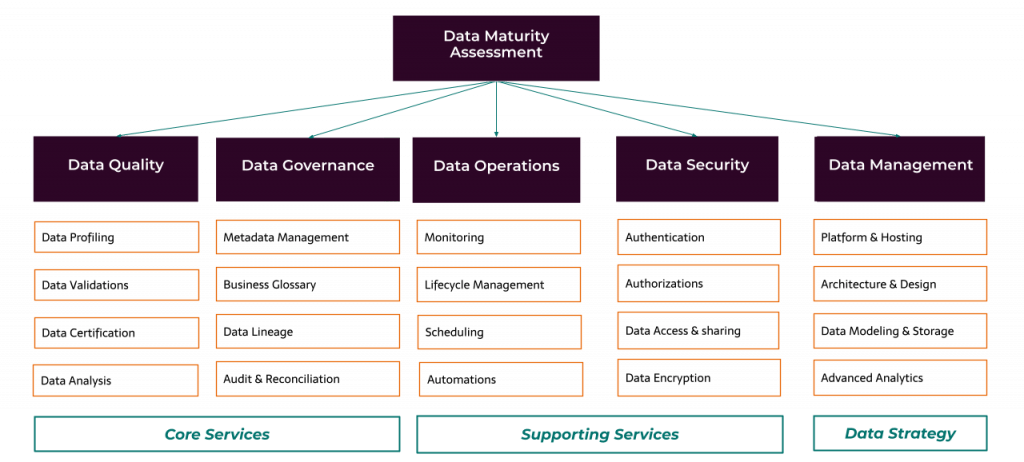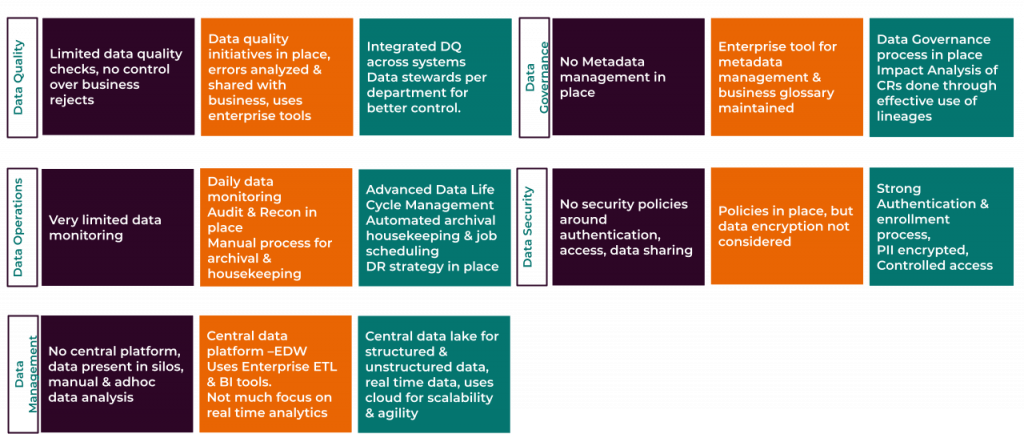What is Data Maturity?
The extent of an organizations’ capability in leveraging their data, defines their data maturity level. The stages in which an organization’s data maturity is assessed can be laid out with a data maturity model. The model indicates how effectively the organizations can leverage their data in a methodical manner. It further allows them to set the base for strategies and actions to achieve the desired level of data maturity.
Why Data Maturity Assessment is Necessary
It is necessary that organizations measure and manage the extent of data being leveraged. As organizations strengthen their efforts toward reducing time-to-market, leveraging data as an asset to improve business agility and market readiness is imperative. Data maturity assessments (DMA) are crucial to business strategies, enabling quicker insights and market predictions even as helping organizations in being future ready.
Data maturity assessments uncover where an organization stands in terms of maturity level, providing quantitative measures for assessing existing data strategies. It further helps in strengthening the confidence and trust of customers and stakeholders. A robust DMA framework facilitates organizations in identifying and evaluating their present level while taking steps for moving to the next level.
Key Domains of Data Maturity Assessment
It is important that organizations focus on assessing the existing data platform, strategy, and architecture based on the defined domains. The assessment is done based on three functions, namely, process, people, and technology.

- Data Quality: Improving, cleansing, and validating the data within the platform.
- Data Governance: Tracking the various data governance initiatives implemented.
- Data Operations: Monitoring and tracking day-to-day data transitions.
- Data Security: Understanding key controls for data security assurance.
- Data Management: Effectively managing the data architecture and platform.
Performing Data Maturity Assessment
Our proposed DMA framework involves five stages, namely, assimilate, assess, analyze, advocate, and amend.

Assimilate
This stage involves defining the domains for data maturity assessment and understanding the pain areas. It defines the functions and processes within the domains that are considered for analysis as part of the assessment.
Assess
In this stage, consultants will ask questions associated with defined domains. Workshops and interviews with key industry stakeholders are conducted. Stakeholders may include program managers, architects, data owners, and business leaders. All of them in collaboration decide on the ratings of maturity for each domain.
Analyze
Based on the responses to interviews and workshops conducted, organizations are able to proceed with a precise understanding of the pain areas. It helps them identify the bottlenecks for mitigation and moving towards higher maturity levels, which include people-related challenges, process issues, and technology limitations.
Advocate
The advocate stage is where enhancements and improvements for all functions and processes are suggested. Also, the best practices that need to be followed while making these enhancements and improvements are recommended.
Amend
In this stage, the feedback from the stakeholders is considered for recommendations to make further changes. This helps in ensuring that the desired state of data is achieved. All these results are documented for the next assessment cycles or mitigating any deviations if/when they occur.
How to Achieve A Leader-Level Data Maturity?
The following figure shows best practices for organizations to achieve and maintain a leader-level data maturity through accurate domain evaluations.

Steps to be taken by Organizations to Move Towards Higher Maturity Level
- People: Moving to the leader position needs executive sponsorships for data initiatives and improving the experience of the data staff. Organizations should establish a dedicated team as platform custodians while realizing seamless communication between application and platform teams.
- Technology: Organizations should exhibit a data-driven tech culture with a data governance council in place. This helps in reducing the pressure on IT teams, directing the focus toward business innovation and self-reliance.
- Process: Organizations must build capabilities for making continuous improvement of existing processes & embracing newer technologies, such as artificial intelligence, machine learning, and advanced analytics. It helps them in accelerating their application and data modernization even as advancing their data lifecycle management.
To Conclude
The data ecosystem varies between organizations. Benefitting from vast data resources and establishing a well-maintained data maturity flow is the need of the hour for businesses. Data and analytics investment is a top priority for organizations to empower their business by leveraging their data for incisive insights.





















